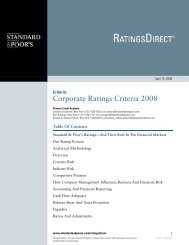European Infrastructure Finance Yearbook - Investing In Bonds ...
European Infrastructure Finance Yearbook - Investing In Bonds ...
European Infrastructure Finance Yearbook - Investing In Bonds ...
Create successful ePaper yourself
Turn your PDF publications into a flip-book with our unique Google optimized e-Paper software.
The rating<br />
Standard & Poor’s project debt ratings address<br />
default probability--or, put differently, the level of<br />
certainty with which lenders can expect to receive<br />
timely and full payment of principal and interest<br />
according to the terms of the financing<br />
documents. Unlike corporate debt, project-finance<br />
debt is usually the only debt in the capital<br />
structure, and typically amortizes to a schedule<br />
based on the project’s useful life. Importantly, also<br />
unlike our corporate ratings, which reflect risk<br />
over three-to-five years, our project debt ratings<br />
are assigned to reflect the risk through the debt‘s<br />
tenor. If refinancing risk is present, we<br />
incorporate into the rating the ability of the<br />
project to repay the debt at maturity solely from<br />
the project sources. Our project ratings often<br />
factor in construction risk, which in many cases<br />
can be higher than the risk presented by expected<br />
operations once the project is completed. <strong>In</strong> some<br />
cases, the construction risk is mitigated by other<br />
features, which enables the debt rating to reflect<br />
our expectations of long-term post-construction<br />
performance. Otherwise, we will rate to the<br />
construction risk, but note the potential for<br />
ratings to rise once construction is complete.<br />
Another important addition to our projectdebt<br />
ratings is the recovery rating concept that<br />
Standard & Poor’s began to assign to secured<br />
debt in late 2003. The recovery rating estimates<br />
the range of principal that lenders can expect to<br />
receive following a default of the project. Our<br />
recovery scale is defined in table 1. We define the<br />
likely default scenario, and then assess recovery<br />
using various techniques, such as discounted cashflow<br />
analysis or EBITDA multiples. Or, we will<br />
examine the terms and conditions of project<br />
assets, such as contracts and concession<br />
Table 1 - Standard & Poor’s Recovery Scale<br />
Recovery Recovery Recovery<br />
rating description expectations*<br />
1+ Highest expectation,<br />
full recovery<br />
100%¶<br />
1 Very high recovery 90%-100%<br />
2 Substantial recovery 70%-90%<br />
3 Meaningful recovery 50%-70%<br />
4 Average recovery 30%-50%<br />
5 Modest recovery 10%-30%<br />
6 Negligible recovery 0%-10%<br />
*Recovery of principal plus accrued but unpaid interest at the time of<br />
default. ¶Very high confidence of full recovery resulting from significant<br />
overcollateralization or strong structural features.<br />
STANDARD & POOR’S EUROPEAN INFRASTRUCTURE FINANCE YEARBOOK<br />
PROJECT FINANCE/PUBLIC-PRIVATE PARTNERSHIPS<br />
agreements, for example, to estimate the expected<br />
recovery. The added importance of the recovery<br />
rating is that recovery can affect the ratings on<br />
certain classes of project debt when more than<br />
one class of debt is present.<br />
Framework for Project <strong>Finance</strong> Criteria<br />
Thorough assessment of project cash flows<br />
requires systematic analysis of five principle<br />
factors:<br />
• Project-level risk<br />
• Transactional structure<br />
• Sovereign risk<br />
• Business and legal institutional<br />
development risk<br />
• Credit enhancements<br />
Project-Level Risks<br />
Project-level risk, or the risks inherent to a<br />
project’s business and within its operating<br />
industry, will determine how well a project can<br />
sustain ongoing commercial operations<br />
throughout the term of the rated debt and, as a<br />
consequence, how well the project will be able to<br />
service its obligations (financial and operational)<br />
on time and in full.<br />
Specifically, we look at a project’s:<br />
• Contractual foundation. Operational and<br />
financing contracts--such as offtake<br />
agreements, concessions, construction<br />
arrangements, hedge agreements, loan<br />
contracts, guarantees--that, along with the<br />
physical plant, serve as the basis of the<br />
enterprise.<br />
• Technology, construction, and operations.<br />
Does it have a competitive, proven<br />
technology, can construction be performed<br />
on time and on budget, and can it operate in<br />
a manner defined under the base case?<br />
• Resource availability. Capacity to<br />
incorporate “input” resources, such as wind<br />
or natural gas.<br />
• Competitive-market exposure. Competitive<br />
position against the market in which it<br />
will operate.<br />
• Counterparty risk. Risk from relying on<br />
suppliers, construction companies,<br />
concession grantors, and customers.<br />
• Financial performance. Risks that may affect<br />
forecast results, and cash-flow variability<br />
under likely stress scenarios.<br />
NOVEMBER 2007 ■ 95



